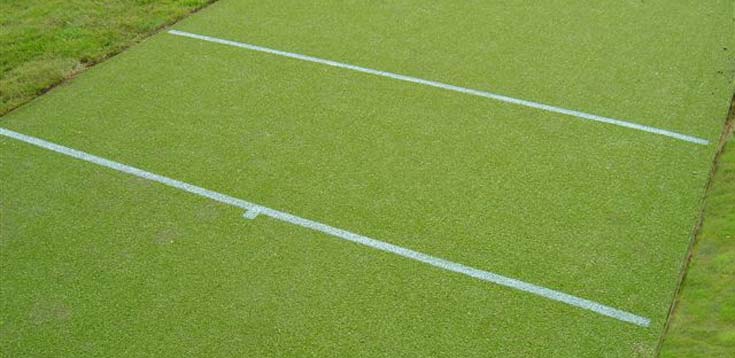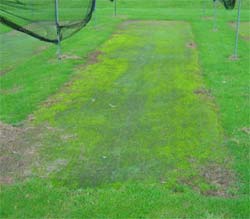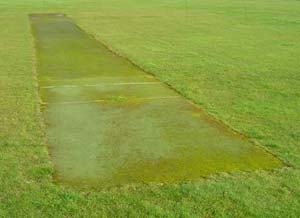We use cookies to make your browsing experience better, personalise content or ads and analyse our traffic. By clicking “Allow Cookies”, you consent to our use of cookies. Learn more.
Cricket Carpet Maintenance
Cricket carpets are typically installed over concrete or 'dynamic' (hard porous) bases.
Whilst some information on this page will apply to both types of base, where appropriate, we've separated base specific information into its own section below.
To jump straight to the required section, please use the links below:
General Cricket Carpet Maintenance
"How do we mark out the creases, and what with?"
Few paints bond well to the polypropylene fibres used in the manufacture of cricket carpets, so re-marking will have to be carried out on a regular basis. White emulsion paint can be used and white aerosol traffic marking paint is convenient, but may take a few coats for a strong line. The creases can be masked with a crease marker, wooden battens, or masking tape.

Hard Porous (Dynamic) Bases
"Our wicket has become uneven and bounce is poor, how do we correct this?"
Wickets with hard-porous dynamic stone bases are low maintenance rather than no maintenance.

The original installer of the wicket should provide ongoing maintenance recommendations which should be followed to ensure the non-turf wicket performs as it should. This will typically comprise pre-season rolling before first use to firm up the base stone which gets loosened during the winter by the wet and frost.
If this rolling is not carried out and the wicket is played on, parts of the base will become compacted whilst other parts less so, quickly leading to unpredictable or just poor bounce. Over time if this continues the base aggregate will go out of level further adding to the problem.
It may be possible to correct this with rolling the cricket carpet from above; this will have most effect if the aggregate beneath is wet after rain. If maintenance has been neglected for a long period it won't be possible to correct it by rolling from above. The cricket carpet would need to be removed and the base aggregate re-graded, levelled, and re-compacted before the cricket carpet is refitted.
"The carpet on our cricket wicket gets covered in moss and algae out of season. Can we treat this and prevent it reoccurring?"

Moss and algae only grow where conditions suit them, which as with natural turf is generally due to damp conditions resulting from poor drainage.
Non-turf wickets are initially installed at or just above the level of the surrounding field so drain well. Over time the ground rises up around the carpet and the wicket base can settle resulting in the wicket sitting lower than the surrounding field. This creates a "pond" effect. Over the winter and spring the carpet sits waterlogged resulting in ideal growing conditions for moss and algae. This is both unsightly and can make the surface very slippery.
The playing surface can be pressure washed to remove the moss and algae. However, long term action needs to be taken to discourage moss and algae from growing in the first place. A cricket surface specialist will be able to advise further on individual cases to determine the most practical course of action to remedy this problem.
It may be possible to roll the surrounding field to reduce the level back to that of the wicket. A more practical solution may be to top up the hard-porous stone base with additional suitable stone to raise the level of the playing surface to just above the level of the surrounding field.
Concrete Bases
"We have a cricket wicket with a concrete base which plays too fast and the bounce is too high. Can we do anything about this?"
No, not really. The concrete dictates the pace and bounce of the cricket ball and generally whatever carpet you install over it has little effect on this. We have previously experimented using different combinations of pads under playing surfaces and there was not a noticeable difference.
Loose laid surfaces and those with a backing such as PRACTICE TURF PVC BACKED are slightly slower and lower bouncing than if a cricket carpet is bonded directly to the concrete.
Concrete bases have the advantage of a no maintenance requirement and are vandal resistant, but if you require a non-turf wicket that plays closer to a natural turf wicket it has to be a hard-porous aggregate base.
|
< Return to Cricket Downloads & Resources
|



